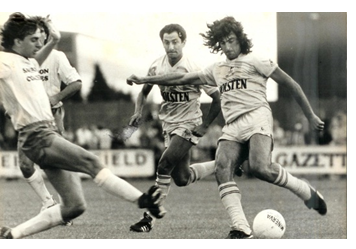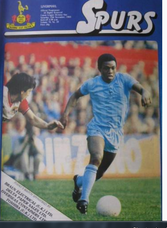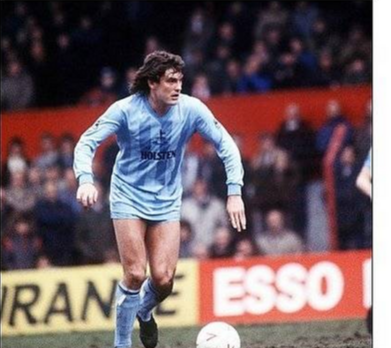 For European games, between 1983 and 1985, Le Coq Sportif, produced an all-white home kit of a similar design, but on both of the home and away shirts the club crest and manufacturers logo were placed back on the left and right breast respectively, with the smaller Holsten logo still being used in televised and European matches till 1986. There were a couple of kit anomalies during this time, in April 1984, the 1980-82, yellow away kit,now with Holsten branding across the chest, was revived as an emergency third kit for the match at QPR, as both the home and away shirts would have clashed. This was worn with the normal home navy shorts. This shirt was also worn for the UEFA Cup Semi Final 1st leg away to Hajduk Split that month, where this time it was matched with the normal white shadow striped “European”shorts.Then in June 1984, Spurs played in an end of season tournament in Swaziland, in southern Africa, in their normal home kit, where they were sponsored by Black Cat, apparently a local casino.  In 1985, Spurs dropped Le Coq Sportif and signed up with Danish manufacturers, Hummel, who continued the trend for innovation. Spurs for the first time domestically, played in a striking all-white home domestic kit, featuring a navy blue chevron pattern across the chest and down the sleeves and navy blue diagonal pin stripes from the chest band up. The away kit featured shirts of two toned diagonal light blue stripes with interspaced white and navy diagonal pinstripes, light blue shorts and socks and, with white chevrons down the shirt sleeves and shorts. These two kits were interchanged as clashes demanded, meaning that Spurs now regularly played in white shirts and light blue shorts, which just did not seem right.  From the 1986/87 season, Spurs began a cycle of introducing a least one new kit per season. For this season a new away kit was introduced (with the old light blue kit being relegated to the role of third kit) of a similar design to the previous away kit, butwithtwo tone diagonal navy blue stripes, interspaced with diagonal pin stripes of light blue and white. It had a white collar and cuffs with a single navy blue cadet stripe. This was matched with navy blue shorts and socks. This colour choice was interesting, as at this stage, dark colour shirts were still technically banned, but somehow Spurs got around it. Before the away game at Coventry in December 1986, the referee, deemed that this kit clashed with Coventry’s light blue and white stripes and white shorts! So for this game Tottenham played in borrowed Coventry yellow change shirts! For the 1987 FA Cup Final, they introduced a new shirt that would be used for the following two seasons. The shirt was made of an artificial material with chevrons in the pattern, a white shadow chevron pattern down the sleeve and a white open neck collar with a navy blue cadet stripe in the insert. Initially, for the Final,Spurs carried over that seasons colours of all white, which saw this was matched with white shorts with a navy waist band and a white shadow chevron stripe and “THFC” written down the side and white socks, butfor the two seasons of use, this shirt was matched with returning navy blue shorts with a white waist band. Infamously in the final, six of the players had shirts with the Holsten branding missing, due to a mix up that had seen a number of youth team shirts, for which alcohol sponsorship was banned, sent off for Cup Final embroidery. In 1988/89, a new dazzling all yellow away kit was introduced, with Hummel now marked into the fabric, a wrap-around v neck collar of yellow with a navy cadet stripe and twin navy chevrons on the sleeves and shorts. The final white Hummel home shirt was introduced for the 1989/90 season, again with Hummel marked into the fabric, a white V neck, with a single navy blue cadet stripe at the neck complete with THFC monogram and pairs of navy blue chevrons on the sleeves.Again this was matched with navy shorts now with a broad white stripe down each side, white trim around the bottom and “THFC”, now in navy, written down the side and white socks. By 1990 though, Spurs had got themselves into major financial troubles as their attempts at business expansion, including buying the UK arm of Hummel had collapsed. As part of a desperate recovery plan Spurs re-signed with long term UK manufacturer Umbro, whose kits they had previously worn for some forty years from 1937 to 1977. The new kit was introduced for the 1991 FA Cup Final and again Spurs brought forthanother innovative strip. Still, featuring a white shirt, but now with a navy blue polo neck collar, navy blue shorts and the return of navy blue socks, with a white turn-over for the first time since 1967. But the most striking feature of the kit, was the long, generously cut shorts, reminiscent of the 1950’s, which within two years became de-rigour across the football world and remains so today. Into 1991, disappointingly, Spurs continued to wear this home kit for their ECWC campaign, foregoing their tradition of wearing all-white in Europe. To complement this kit, Umbro produced two further striking designs for Spurs away kits. The all-yellow change kit had a navy blue polo collar, but featured an abstract chequered design in navy blue, white and grey patches on the right shoulder and shorts, whilst the all-light blue third kit sported "SPURS" woven into the fabric and proudly displayed across the upper body of the shirt.
Umbro’s final home shirt was introduced in 1993. For the first time on a Spurs home shirt, yellow trimming was added to the navy blue collar and shorts. The crest was now mounted on its own shield that was stitched to the left breast, a fashion fad of kit design in the mid ‘90’s. This kit also saw them revert to white socks, The final away kit of the Umbro era, was worn for one season only. This was the kit made famous by Jürgen Klinsmann in his debut (and dive) against Sheffield Wednesday. It was an all-navy blue kit with purple splashes down the left side of the shirt, right sleeve and shorts and a white winged collar and cuffs. Again, it featured the crestmounted on its own purple shield that was stitched to the left breast. At the end of 1995, Umbro again were dropped as Spurs’ the kit supplier, so after 18 years, with their second demise, we have come full circle from where this article started. Tony Sealey. Parts 1-3 appeared earlier this year and can be found starting at - http://www.indiaspurs.com/blog/tottenham-hotspur-kit-history-1-1945-1977 Part 4- Which appeared earlier this week. - http://www.indiaspurs.com/blog/tottenham-hotspur-kit-history-4-1977-1985 Tony also answered your questions at - http://www.indiaspurs.com/blog/talking-tottenham-with-tony-sealey Editors Notes- Once again thank to Tony for his insightful look into Tottenham's history. We have experienced technically problems with these series and we hope this hasn't spoiled your enjoyment.
2 Comments
keith
9/3/2017 01:22:34 pm
http://www.indiaspurs.com/blog/talking-tottenham-with-tony-sealey
Reply
Leave a Reply. |
Features
Flying Down to Rio History of T.H.F.C. Tribute to Bill Nicholson Talking Tottenham Early Legends The Road to Turin International Connections Hotspur Towers Most Read Articles
The 100 Year War Interview with Marina Sirtis A Long Dark Shadow By Royal Appointment School Report: An Insight into the Younger Eric Dier Dear Jimmy All Change At Spurs Hotspur Towers History Of THFC: Part 1 Passage to India: Rohan Rickets Thanks For The Memories Our Tommy Carroll The AVB Files: Part1 The Lilywhites You The Jury The Hand Of Hugo Connection - Argentina Creating a Reputation One Hotspur Archives
August 2018
Categories
All
|



 RSS Feed
RSS Feed

